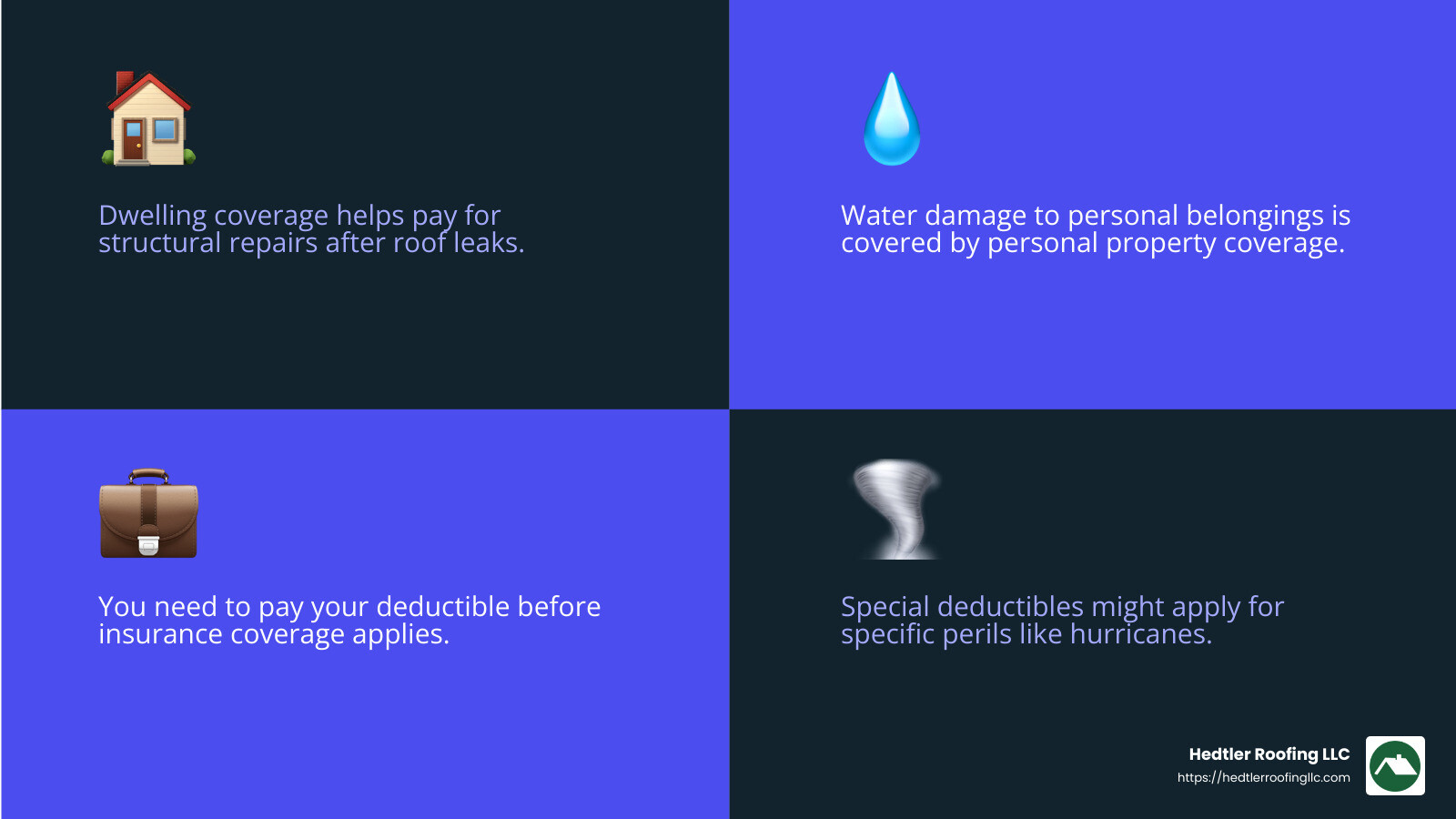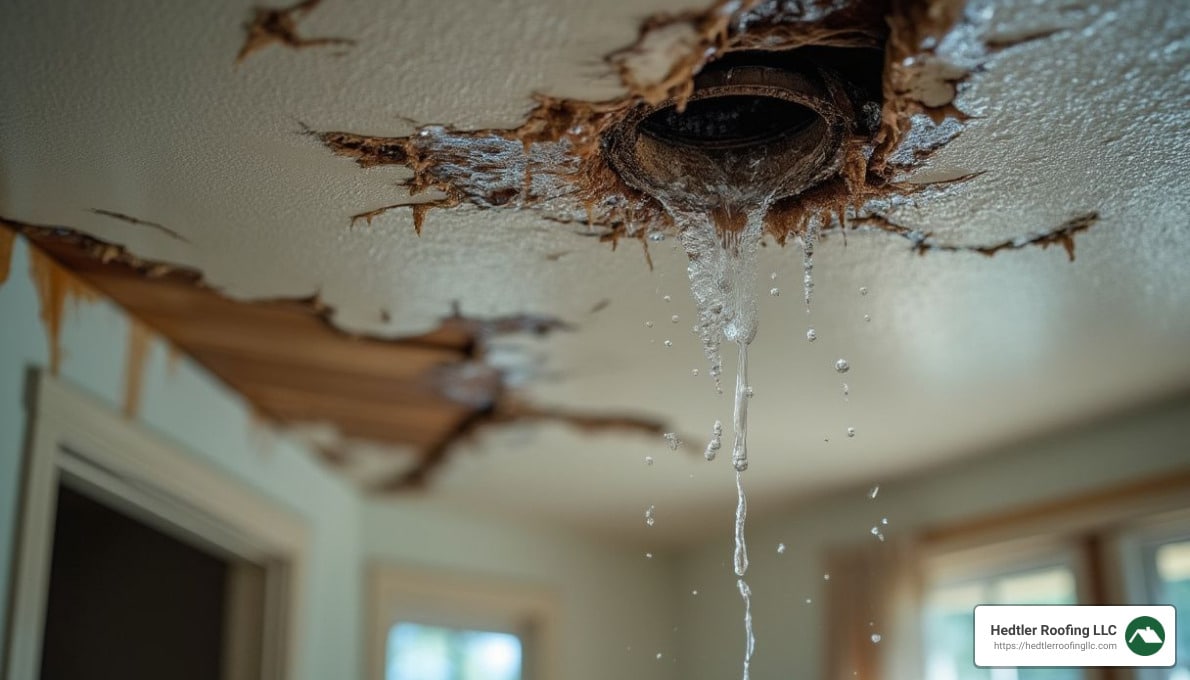Does Home Insurance Cover Roof Leaks? Top 5 Secrets 2024
Does home insurance cover roof leaks?
The answer typically depends on what caused the leak. Here are key points to consider:
– Covered Perils: Insurance usually covers leaks from sudden events like storms or fires.
– Exclusions: Normal wear and tear or neglect are not covered.
– Deductible: You’ll pay this portion before insurance chips in for repairs.
When water drips from the ceiling, it’s a homeowner’s nightmare that might lead to substantial damage. Whether your insurance will cover it plays a big role in your recovery process. Understanding the specifics of your policy helps protect your home more effectively.
At Roof Experts, we have deep expertise in guiding Massachusetts homeowners through these concerns. I’m Jason Hedtler, and with over 20 years of experience, we focus on delivering exceptional roofing solutions you can trust. Knowledge about does home insurance cover roof leaks aids in making informed decisions about maintenance and claims, ensuring your peace of mind.

Essential does home insurance cover roof leaks terms:
– ceiling leaking water
– roof flashing repair
– handyman roof repair
What Causes Roof Leaks?
Roof leaks can be a major headache for homeowners. Understanding their causes can help you prevent them and protect your home.
Weather Events
Massachusetts is no stranger to harsh weather. Storms, heavy rain, and strong winds can damage your roof’s structure. Hailstones can crack shingles, while violent winds might blow them away, leaving your roof exposed. Fire is another peril that can damage your roof and lead to leaks.
Wear and Tear
Over time, every roof will age. Shingles dry out and become brittle, making them more susceptible to damage. Missing or broken shingles are common culprits for leaks. Regularly inspecting your roof can help spot these issues early.
Poor Maintenance
Neglecting your roof’s upkeep can lead to significant problems. Clogged gutters, for example, prevent proper drainage, causing water to back up and seep under your shingles. Keeping gutters clear is a simple step that can prevent leaks.
Bad Workmanship
Sometimes, the problem starts right at installation. Improper nail placement, poorly installed flashing, or subpar materials can lead to leaks. Always hire a reputable contractor for roof work to ensure high-quality installation and avoid future headaches.
Understanding these causes helps you take preventive measures, reducing the risk of leaks and potential damage. Regular maintenance and inspections are key to a healthy roof. At Roof Experts, we’re committed to helping Massachusetts homeowners maintain their roofs with expert guidance and services.
Does Home Insurance Cover Roof Leaks?
Home insurance can be a lifesaver when unexpected roof leaks occur. However, whether home insurance covers roof leaks often depends on the cause of the leak. Let’s explore what is typically covered and what is not.
Covered Perils
Home insurance usually covers roof leaks caused by specific covered perils. These are sudden and accidental events that damage your roof. Here are some common examples:
- Storms: If a storm with high winds blows shingles off your roof, leading to a leak, your policy will likely cover the repairs.
- Hail: Hailstones can crack or puncture your shingles, causing leaks. This type of damage is usually covered.
- Fire: Fires can damage your roof, and any resulting leaks will typically be covered under your policy.
These events are considered accidental and beyond the homeowner’s control, which is why they are included in standard home insurance policies.
Exclusions
Unfortunately, not all roof leaks are covered. There are several exclusions that homeowners should be aware of:
- Neglect and Lack of Maintenance: If a leak occurs because the roof was not properly maintained, your insurance will likely not cover it. This includes issues like clogged gutters or failing to replace damaged shingles.
- General Wear and Tear: Over time, roofs naturally deteriorate. Insurance policies generally do not cover leaks caused by aging or normal wear and tear.
- Bad Workmanship: Poor installation or subpar repairs can lead to leaks. If your roof leaks due to bad workmanship, the cost of repairs may not be covered.
Understanding these exclusions is crucial. Regular maintenance and choosing a reputable contractor for installations and repairs can help you avoid these pitfalls.
In summary, while home insurance can cover roof leaks caused by unexpected events like storms or hail, it’s important to maintain your roof to avoid leaks from neglect or wear and tear. For Massachusetts homeowners, Roof Experts offers expert services to help keep your roof in top condition.
How to File a Claim for a Roof Leak
When you find a roof leak, it’s important to act quickly to minimize damage and ensure your insurance claim process goes smoothly. Here’s a step-by-step guide to help you through the process.
Identifying the Source of the Leak
Start by pinpointing where the leak is coming from. Common signs include water marks on ceilings or mold along the walls. Inspect your attic for any water damage or mold, especially during rainy weather.
- Attic Inspection: Look for wet insulation, water stains, or rotted wood.
- Roof Inspection: Check for missing, cracked, or damaged shingles. Inspect chimney and vent pipes for cracks.
By identifying the source, you can better describe the issue when contacting your insurance company.
Documenting the Damage
Once you’ve identified the leak, document everything. This will be crucial for your insurance claim.
- Photos and Videos: Capture clear images and videos of the damage. Include close-ups and wide shots to show context.
- Written Descriptions: Note down when you first noticed the leak and any actions you’ve taken so far.
This documentation will support your claim and help your insurer understand the extent of the damage.
Temporary Solutions
Before professional help arrives, take temporary measures to prevent further damage.
- Buckets and Containers: Place these under the leak to catch dripping water.
- Fans and Wet Vacuum: Use these to dry out affected areas and prevent mold growth.
- Move Items: Relocate furniture and electronics away from the leak. If moving isn’t possible, cover them with plastic sheeting.
These steps can save your belongings from water damage and keep your living space dry.
Contacting Your Insurance Company
With documentation in hand, it’s time to contact your insurance provider.
- Reporting the Claim: Call your insurer as soon as possible. Provide them with a detailed account of the damage and how it occurred.
- Providing Documentation: Share the photos, videos, and written descriptions you’ve prepared.
- Answering Questions: Be ready to answer any questions they might have about the leak and your maintenance history.
Being prompt and thorough in your communication can expedite the claim process, helping you get the repairs you need more quickly.
By following these steps, you can efficiently manage a roof leak and steer the insurance claim process. Up next, we’ll explore whether home insurance covers the water damage resulting from a roof leak and what coverage options might be available.
Will Home Insurance Cover Water Damage from a Roof Leak?
When a roof leak occurs, it can lead to more than just a hole in your ceiling. Water damage might affect the structure of your home and your personal belongings. Understanding how your insurance policy covers these damages is crucial.
Dwelling Coverage
Dwelling coverage is a part of your homeowners insurance that helps pay for repairs to the structure of your home. If a roof leak caused by a covered peril—like a storm or fire—damages your home, this coverage can help with repairs or even a roof replacement.
- Structure Repair: This includes fixing walls, ceilings, and floors impacted by the leak.
- Roof Replacement: If the damage is extensive, your policy might cover the cost of a new roof. However, you’ll need to pay your deductible before the coverage kicks in. That some policies have special deductibles, like a hurricane windstorm deductible, which might be higher.

Personal Property Coverage
Personal property coverage protects your belongings inside the home. If water from a roof leak damages your furniture, electronics, or clothing, this part of your policy can help cover replacement costs.
- Damaged Belongings: Items like furniture and electronics that are damaged by water can be replaced or repaired up to the coverage limits of your policy.
- Coverage Limits: Be aware that there are limits to how much your policy will pay. It’s important to know these limits so you’re not caught off guard during a claim.
Mold Coverage
Mold can be a tricky issue when it comes to insurance. Generally, mold resulting from a sudden event, like a roof leak, may be covered, but this depends on your policy specifics.
- Policy Specifics: Some policies include mold coverage, but often only if the mold results from a covered peril. Check if your policy has any endorsements that expand mold coverage.
- Time Passed Since Initial Cause: It’s crucial to address leaks and mold quickly. Delays can lead to claim denials, as insurers might argue that the mold was due to neglect.
Understanding these coverage areas can help you better steer the aftermath of a roof leak. Being informed ensures you know what to expect from your insurance provider and helps you make the best decisions for your home.
Next, we’ll dig into how to prevent roof leaks through regular maintenance and inspections, helping you avoid these issues in the first place.
Preventing Roof Leaks
Keeping your roof in top condition is crucial to avoiding leaks and potential water damage. Here are some practical steps you can take to prevent roof leaks.
Regular Inspections
Regular inspections are your first line of defense against roof leaks. Aim to inspect your roof at least once a year, and after major storms. Look for damaged shingles, which might be cracked, curled, or missing. Pay attention to chimney and vent pipes as well, since faulty flashing around these areas can lead to leaks.
- Roof Condition: Check for signs of wear and tear. If you notice any issues, address them promptly to prevent further damage.
- Damaged Shingles: Look for loose or missing shingles. These can expose your roof to water damage.
- Chimney and Vent Pipes: Ensure that the flashing around these structures is intact and not corroded.
Gutter Cleaning
Your gutters play a vital role in directing water away from your roof. Clogged gutters can cause water to back up and seep into your home.
- Debris Removal: Regularly clean your gutters to remove leaves, twigs, and other debris. This prevents blockages and ensures water flows freely.
- Water Flow: Make sure downspouts direct water away from your home’s foundation. This helps prevent water from pooling on your roof.
Post-Storm Checks
After a storm, inspect your roof for any damage. Even if everything seems fine from the ground, some issues might not be immediately visible.
- Inspect for Damage: Use binoculars to get a closer look at your roof without climbing up. Look for missing shingles and damaged flashing.
- Leaks: Check your attic for any signs of water intrusion, like damp insulation or water stains.
Professional Maintenance
Hiring a professional roofer for regular maintenance can save you money in the long run. A pro can spot issues that you might miss and perform preventive repairs.
- Hire a Roofer: Choose a reputable company for your roof maintenance needs. They can conduct a thorough inspection and suggest necessary repairs.
- Regular Check-Ups: Schedule regular check-ups to catch problems early. This can help extend the life of your roof and prevent costly repairs.
By following these steps, you can help keep your roof in excellent condition and reduce the risk of leaks. Regular maintenance not only protects your home but also ensures peace of mind.
Next, we’ll explore common questions about roof leak coverage, helping you understand what to expect from your insurance policy.
Frequently Asked Questions about Roof Leak Coverage
Are Ceiling Leaks Covered by Homeowners Insurance?
Yes, ceiling leaks can be covered by homeowners insurance, but it largely depends on the cause. If the leak is due to a covered peril, such as a storm or a burst pipe, your policy is likely to cover the damage to ceilings, furniture, floors, and walls. However, if the leak results from neglect or regular wear and tear, the coverage might not apply.
It’s crucial to understand which perils are covered under your policy. For instance, if a storm blows off shingles and rainwater damages your ceiling, that’s typically covered. But if the damage is due to poor maintenance, you might be on your own.
How to Make a Successful Water Leak Insurance Claim?
To make a successful water leak insurance claim, start by stopping the water flow to prevent further damage. This might involve shutting off water sources or using buckets to catch drips.
Next, document the damage thoroughly with photos and videos. This evidence will support your claim. Then, report the claim to your insurance company as soon as possible. Provide them with all necessary documentation and be ready to answer questions about the incident.
Consider hiring a professional clean-up service to handle any water extraction and drying. They can help mitigate damage and prevent mold growth, which can strengthen your claim.
Is Mold from a Roof Leak Covered by Insurance?
Mold coverage is a tricky area in insurance policies. Generally, mold resulting from a sudden event like a roof leak caused by a covered peril might be covered. However, if mold results from ongoing issues like appliance leaks or HVAC malfunctions, it might not be covered.
To improve your chances of coverage, address mold issues promptly and document everything. Check your policy specifics, as some insurers offer endorsements for mold coverage. The quicker you act, the better your chances of a favorable outcome.
Understanding these aspects of roof leak coverage can help you steer the complexities of homeowners insurance. Up next, we’ll discuss how to ensure your roof stays leak-free with preventive measures.
Conclusion
In summary, understanding does home insurance cover roof leaks is crucial for every homeowner. While insurance can provide a safety net for unexpected events like storms, it’s important to know the specifics of your coverage. Not all scenarios are covered, especially those resulting from neglect or normal wear and tear.
For homeowners in Massachusetts, having a reliable partner like Roof Experts can make all the difference. With over 20 years of experience, we specialize in detailed roof inspections and high-quality workmanship, ensuring your home remains protected.
Regular roof inspections are key to preventing leaks. By catching issues early, you can avoid costly repairs and improve the chances of successful insurance claims. Our team at Roof Experts is dedicated to providing thorough inspections and maintenance to keep your roof in top condition.
If you’re a Massachusetts homeowner looking for expert roofing services, don’t hesitate to reach out to us. We are here to help with all your roof repair and maintenance needs, offering peace of mind with every service.


